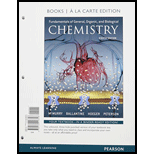
Interpretation:
The molarity and normality of solution prepared by dissolving 5 g of
Concept Introduction:
Moles: One mole is equivalent to the mass of the substance consists of same number of units equal to the atoms present in
Normality: It generally expresses the concentration of acid or base as equivalents of acid or base present in one liter of the solution.
Molarity: The concentration for solutions is expressed in terms of molarity as follows,
The normality for any acid or base equals the molarity times of the number of
Equivalent of Acid: Generally, 1 equivalent of ion is the number of ions which has charge of one mole.
Equivalent of Base: In case of bases negative charge is of interest therefore, one equivalent of base consists of 1 mole of
Want to see the full answer?
Check out a sample textbook solution
Chapter 10 Solutions
Fundamentals of General, Organic, and Biological Chemistry, Books a la Carte Plus Mastering Chemistry with Pearson eText -- Access Card Package (8th Edition)
- The pH of black coffee is 5, and that of milk of magnesia is 10. Is the coffee twice as acidic as milk of magnesia?arrow_forwardWhat is the molarity of a solution that contains 50.0 g of vitamin B1 hydrochloride (molar mass = 337 g/mol) in 160 mL of solution?arrow_forwardWhat mass in grams of dextrose and sodium chloride are required to prepare 250 mL of D10 NS electrolyte?arrow_forward
 Principles Of Radiographic Imaging: An Art And A ...Health & NutritionISBN:9781337711067Author:Richard R. Carlton, Arlene M. Adler, Vesna BalacPublisher:Cengage Learning
Principles Of Radiographic Imaging: An Art And A ...Health & NutritionISBN:9781337711067Author:Richard R. Carlton, Arlene M. Adler, Vesna BalacPublisher:Cengage Learning Human Biology (MindTap Course List)BiologyISBN:9781305112100Author:Cecie Starr, Beverly McMillanPublisher:Cengage Learning
Human Biology (MindTap Course List)BiologyISBN:9781305112100Author:Cecie Starr, Beverly McMillanPublisher:Cengage Learning


